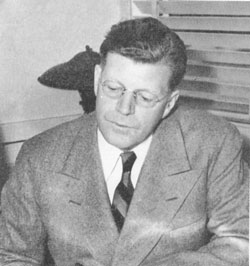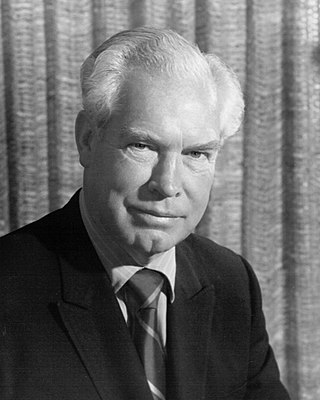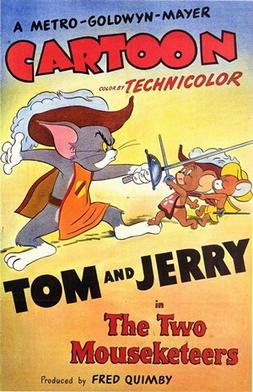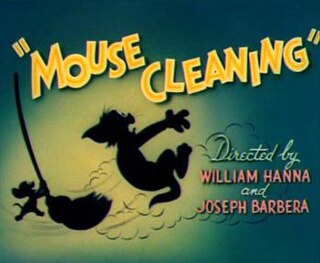
Frederick Clinton Quimby was an American animation producer and journalist best known for producing the Tom and Jerry cartoon series, for which he won seven Academy Awards for Best Animated Short Films. He was the film sales executive in charge of the Metro-Goldwyn-Mayer cartoon studio, which included Tex Avery, Droopy, Butch Dog, Barney Bear, Michael Lah and multiple one-shot cartoons, as well as William Hanna and Joseph Barbera, the creators of Tom and Jerry.

The Cat Concerto is a 1947 American one-reel animated cartoon and the 29th Tom and Jerry short, released to theatres on April 26, 1947. It was produced by Fred Quimby and directed by William Hanna and Joseph Barbera, with musical supervision by Scott Bradley, and animation by Kenneth Muse, Ed Barge and Irven Spence and uncredited animation by Don Patterson.

Droopy is an animated character from the golden age of American animation. He is an anthropomorphic white Basset Hound with a droopy face; hence his name. He was created in 1943 by Tex Avery for theatrical cartoon shorts produced by the Metro-Goldwyn-Mayer cartoon studio. Essentially the polar opposite of Avery's other MGM character, the loud and wacky Screwy Squirrel, Droopy moves slowly and lethargically, speaks in a jowly monotone voice, and—though hardly an imposing character—is shrewd enough to outwit his enemies. When finally roused to anger, often by a bad guy laughing heartily at him, Droopy is capable of beating adversaries many times his size with a comical thrashing.

William Denby Hanna was an American animator, voice actor, and occasional musician who is best known for co-creating Tom and Jerry and providing the vocal effects for the series' title characters. Alongside Joseph Barbera, he also founded the animation studio and production company Hanna-Barbera.

Joseph "Joe" Roland Barbera was an American animator and cartoonist, best known as the co-founder of the animation studio Hanna-Barbera.

Puss Gets the Boot is a 1940 American animated short film and is the first short in what would become the Tom and Jerry cartoon series, though neither are yet referred to by these names. It was directed by William Hanna and Joseph Barbera, and produced by Rudolf Ising. It is based on the Aesop's Fable, The Cat and the Mice. As was the practice of MGM shorts at the time, only Rudolf Ising is credited. It was released to theaters on February 10, 1940, by Metro-Goldwyn-Mayer.
Johann Mouse is a 1953 American one-reel animated cartoon and the 75th Tom and Jerry cartoon, released in theaters on March 21, 1953 by Metro-Goldwyn-Mayer. The short is directed by William Hanna and Joseph Barbera, composed by Scott Bradley, and animated by Kenneth Muse, Ray Patterson, Ed Barge, and Irven Spence. It won the 1952 Academy Award for Best Short Subject: Cartoons, the seventh and last Oscar given to a Tom and Jerry short.

The Two Mouseketeers is a 1952 American one-reel animated cartoon and is the 65th Tom and Jerry short, produced in Technicolor and released to theatres on March 15, 1952 by Metro-Goldwyn-Mayer. It was produced by Fred Quimby and directed by William Hanna and Joseph Barbera. The short is a spoof of Alexandre Dumas' 1844 novel The Three Musketeers and its film adaptations, featuring the mice Jerry and his best friend, Nibbles as the "Mouseketeers" trying to raid the French king's banquet table, which is protected by Tom as a guard. Three years after the cartoon's release, the term "Mousketeer" was also used to refer to the child cast members of the television show, The Mickey Mouse Club.

Mouse Trouble is a 1944 American one-reel animated cartoon short and is the 17th Tom and Jerry short produced by Fred Quimby. It was directed by William Hanna and Joseph Barbera, with music direction by Scott Bradley. The cartoon was animated by Ray Patterson, Irven Spence, Ken Muse and Pete Burness. Mouse Trouble won the 1944 Oscar for Best Animated Short Film, the second consecutive award bestowed upon the series. It was released in theatres on November 23, 1944 by Metro-Goldwyn Mayer and reissued on December 12, 1951.
This is a complete list of the 166 shorts in the Tom and Jerry series produced and released between 1940 and 2021. Of these, 162 are theatrical shorts, one is a made-for-TV short, one is a two-minute sketch shown as part of a telethon, and two are special shorts released on HBO Max.

The Little Orphan is a 1949 American one-reel animated cartoon and the 40th Tom and Jerry cartoon, released in theaters on April 30, 1949 by Metro-Goldwyn Mayer. It was produced by Fred Quimby and directed by William Hanna and Joseph Barbera, with music by Scott Bradley. The cartoon was animated by Irven Spence, Kenneth Muse, Ed Barge and Ray Patterson. The short features Nibbles, a young mouse who is insatiably hungry.
The Night Before Christmas is a 1941 American one-reel animated cartoon and is the third Tom and Jerry short directed by William Hanna and Joseph Barbera, produced by Fred Quimby and animated by Jack Zander, George Gordon, Irven Spence and Bill Littlejohn. It was nominated for the 1941 Academy Award for Best Short Subject: Cartoons, but lost to the Mickey Mouse short film Lend a Paw, making it the only Tom and Jerry cartoon to lose to a Disney film.

The Metro-Goldwyn-Mayer cartoon studio was an American animation studio operated by Metro-Goldwyn-Mayer (MGM) during the Golden Age of American animation. Active from 1939 until 1958, the studio was responsible for producing animated shorts to accompany MGM feature films in Loew's Theaters, which included popular cartoon characters Tom, Jerry, Droopy, Butch, Spike, Tyke, and Barney Bear.
Tee for Two is a 1945 American one-reel Technicolor animated cartoon and is the 20th Tom and Jerry short, first released to theaters on July 21, 1945, by Metro-Goldwyn-Mayer. The short is directed by William Hanna and Joseph Barbera, composed by Scott Bradley, and animated by Ray Patterson, Irven Spence, Pete Burness, and Kenneth Muse.

Mouse Cleaning is a 1948 one-reel animated cartoon and the 38th Tom and Jerry short. The title is a play on "house cleaning". It was produced in Technicolor and released to theatres on December 11, 1948, by Metro-Goldwyn Mayer and again on February 17, 1956. It was animated by Ray Patterson, Irven Spence, Kenneth Muse and Ed Barge, who were the usual animators for the Tom and Jerry cartoons in the early 1940s up until the late 1950s. It was directed by William Hanna and Joseph Barbera, and produced by Fred Quimby; no writer has yet been credited. The music was scored by Scott Bradley and the backgrounds were created by Robert Gentle.
Raymond Patterson was an American animator, producer, and director. He was born in Hollywood, California, and was the younger brother of animator Don Patterson.
Irven LeRoy Spence was an American animator. He is best known for his work on MGM's Tom and Jerry animated shorts. Spence has been credited variously as Irven Spence, Irvin Spence, and Irv Spence.

Casanova Cat is a 1951 one-reel animated cartoon and is the 55th Tom and Jerry short directed by William Hanna and Joseph Barbera and produced by Fred Quimby.

Saturday Evening Puss is a 1950 one-reel animated cartoon and is the 48th Tom and Jerry short directed by William Hanna and Joseph Barbera. The cartoon was released on January 14, 1950, produced by Fred Quimby, scored by Scott Bradley and animated by Ed Barge, Kenneth Muse, Irven Spence and Ray Patterson. It is the only Tom and Jerry cartoon to feature Mammy's face on-screen, though only briefly. A re-edited version was produced in the 1960s replacing Mammy with a white teenage girl.
Tom and Jerry Golden Collection was a scrapped series of two-disc DVD and Blu-ray sets produced by Warner Home Video that was expected to collect all 161 theatrical Tom and Jerry cartoon shorts released by Metro-Goldwyn-Mayer from the 1940s through the 1960s. Only the first of the three planned volumes was released, on October 25, 2011. It features 37 shorts, roughly one-third of the 113 Tom and Jerry shorts that had been included in the Tom and Jerry Spotlight Collection, a previous DVD series that focused on the shorts directed by William Hanna and Joseph Barbera from 1940 to 1958.











